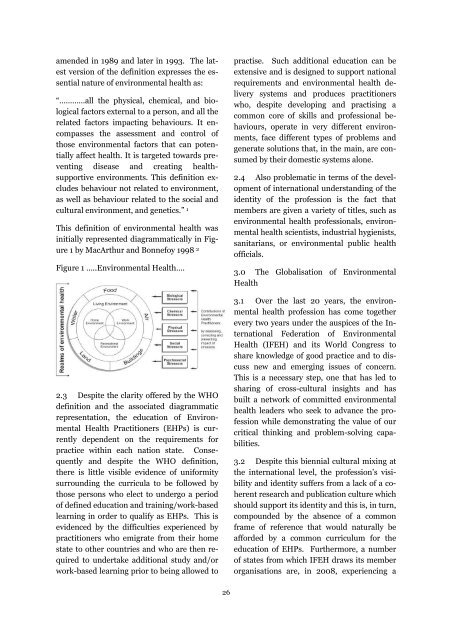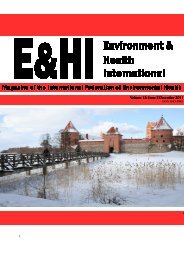ISSN 1683-3805
E&HI Volume 11, No. 1 2009 - International Federation of ...
E&HI Volume 11, No. 1 2009 - International Federation of ...
- No tags were found...
Create successful ePaper yourself
Turn your PDF publications into a flip-book with our unique Google optimized e-Paper software.
amended in 1989 and later in 1993. The latest<br />
version of the definition expresses the essential<br />
nature of environmental health as:<br />
“…………all the physical, chemical, and biological<br />
factors external to a person, and all the<br />
related factors impacting behaviours. It encompasses<br />
the assessment and control of<br />
those environmental factors that can potentially<br />
affect health. It is targeted towards preventing<br />
disease and creating healthsupportive<br />
environments. This definition excludes<br />
behaviour not related to environment,<br />
as well as behaviour related to the social and<br />
cultural environment, and genetics.” 1<br />
This definition of environmental health was<br />
initially represented diagrammatically in Figure<br />
1 by MacArthur and Bonnefoy 1998 2<br />
Figure 1 …..Environmental Health….<br />
2.3 Despite the clarity offered by the WHO<br />
definition and the associated diagrammatic<br />
representation, the education of Environmental<br />
Health Practitioners (EHPs) is currently<br />
dependent on the requirements for<br />
practice within each nation state. Consequently<br />
and despite the WHO definition,<br />
there is little visible evidence of uniformity<br />
surrounding the curricula to be followed by<br />
those persons who elect to undergo a period<br />
of defined education and training/work-based<br />
learning in order to qualify as EHPs. This is<br />
evidenced by the difficulties experienced by<br />
practitioners who emigrate from their home<br />
state to other countries and who are then required<br />
to undertake additional study and/or<br />
work-based learning prior to being allowed to<br />
practise. Such additional education can be<br />
extensive and is designed to support national<br />
requirements and environmental health delivery<br />
systems and produces practitioners<br />
who, despite developing and practising a<br />
common core of skills and professional behaviours,<br />
operate in very different environments,<br />
face different types of problems and<br />
generate solutions that, in the main, are consumed<br />
by their domestic systems alone.<br />
2.4 Also problematic in terms of the development<br />
of international understanding of the<br />
identity of the profession is the fact that<br />
members are given a variety of titles, such as<br />
environmental health professionals, environmental<br />
health scientists, industrial hygienists,<br />
sanitarians, or environmental public health<br />
officials.<br />
3.0 The Globalisation of Environmental<br />
Health<br />
3.1 Over the last 20 years, the environmental<br />
health profession has come together<br />
every two years under the auspices of the International<br />
Federation of Environmental<br />
Health (IFEH) and its World Congress to<br />
share knowledge of good practice and to discuss<br />
new and emerging issues of concern.<br />
This is a necessary step, one that has led to<br />
sharing of cross-cultural insights and has<br />
built a network of committed environmental<br />
health leaders who seek to advance the profession<br />
while demonstrating the value of our<br />
critical thinking and problem-solving capabilities.<br />
3.2 Despite this biennial cultural mixing at<br />
the international level, the profession’s visibility<br />
and identity suffers from a lack of a coherent<br />
research and publication culture which<br />
should support its identity and this is, in turn,<br />
compounded by the absence of a common<br />
frame of reference that would naturally be<br />
afforded by a common curriculum for the<br />
education of EHPs. Furthermore, a number<br />
of states from which IFEH draws its member<br />
organisations are, in 2008, experiencing a<br />
26



